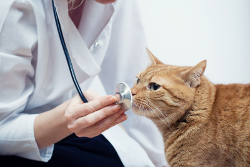Pets are an integral part of households. Often, pets are treated like children or other human relatives in our families. If a child comes down with an illness, parents are quick to diagnose and treat their loved one. Illnesses and diseases also occur in pets. Cats are sweet, loving, soft and cuddly creatures, but at times can be tortured by parasites. These parasites come in the form of cat lice and cat ear mites for many of these cuddly creatures.
Cat Lice
Cat lice are a type of parasite called an ectoparasite. This means they live on the outside of the host’s body but still feed on the host like other parasites do. Cat lice are a type of insect that does not have wings. They are very small, usually around 2 to 4 millimeters in length. They are built to hold on tightly to cat’s fur as they bite and chew on a cat’s skin.
These parasites need the host (your pet) to live out their short lifespans, which is normally around 6 weeks. Without the host, cat lice will die.
Cat lice infestations normally occur more often in unsanitary conditions. Lice cannot be transmitted from cat to human but can be passed from cat to cat through grooming tools or direct contact. Cats that have been infected by this parasite will normally have dry, flaky skin.
The cat lice often look like dandruff to the naked human eye. A cat with a lot of lice can often lose their hair or in extreme cases become anemic due to blood loss. Felines will itch a lot if infected and their hair will often become very matted. The best way to prevent lice in your pet is to keep living conditions clean and free of filth.
Treatment
Luckily, these parasites can be treated in a couple of ways. Over the counter flea shampoos will help to curb the infestation but will not completely rid the cat of the problem if there is a severe infestation. If a more comprehensive treatment is needed to cure your cat’s problem, veterinarians can offer medicated, pyrethin shampoo or topical treatment to eliminate the parasite.
A follow up spray or powder will kill residual eggs that still lie on the cat’s coat. Two weeks after the initial treatment, a follow up treatment is necessary to take care of any nits that remained from the first treatment and hatched.
Cat Ear Mites
Cat ear mites are another parasite that often affects cats. These parasites are crab-like in appearance and attack the ear and ear canal of felines. Cat ear mites are extremely irritating to cats. They cause scratching and head shaking as cats try to relieve themselves from these biting parasites.
Cat ear mites can spread to other family pets if not properly treated in a timely manner. Other symptoms of ear mites include dried blood in the ears, dizziness and unpleasant odor radiating from the cat’s ears.
Treatment
Cat ear mites can be treated quite easily. First, ear mite drops must be applied to your cats’ ears for seven days. This will take care of the majority of the mites around the ear. Unfortunately, cat ear mites can infect the cat’s whole body. Your pet can be bathed in the same pyrethin shampoo that was used to treat cat lice.
It is very important to treat cat ear mites in a timely manner, if they go untreated for an extended period, they could leave your cat deaf or with inflamed ears for a long period of time.
Prevention is the key when dealing with both types of parasites. Lice can be prevented by keeping surrounding clean and sanitary. Ear mites can also be prevented. There are medicines available that a pet owner can administer to their pet that will prevent fleas, ticks and mites. These products are relatively inexpensive and provide quite a bit of protection for any pet. Review our top treatment selection for external parasite.
People love their pets. It is a terrible thought to have your cat in pain because of parasites. Cats, unlike humans, cannot tell their owners what is bothering them. Because of this, it is important to keep a close eye on your cat for signs of infections. This is usually found with changes in behavior, look for excessive scratching or head shaking.
Most importantly, as a pet owner your job is to love and maintain a health environment, so your pet can have a happy life.
Thanks for The Cat Dandruff Clinic, if you liked this article please like us using the side bar .
Related Posts:



[…] and Lice may cause a dermatitis (hypersensitivity to flea bites) on your cats skin. It is one of the most […]